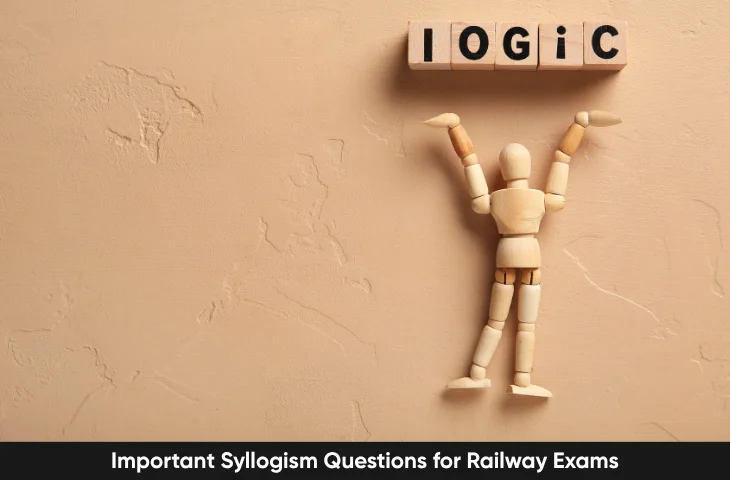Syllogism questions are a key part of the General Intelligence and Reasoning section in Railway Exams. They test your ability to analyze statements, deduce conclusions, and think logically skills that are crucial for RRB NTPC, ALP, and Group D exams.
This article provides a comprehensive guide to Syllogism Questions for Railway Exams, including types of syllogisms, solving techniques, high-yield question patterns, example problems, and a strategic preparation plan.
Why Syllogism Questions are Important in Railway Exams?
Syllogism Questions are very important for Railway Exams. Some of the reasons are given below:
- Weightage: Typically 3–5 questions appear in RRB NTPC, ALP, and Group D exams.
- Scoring potential: These are objective questions — correct logic guarantees full marks.
- Pattern consistency: The style of questions has remained largely consistent in past exams.
- Skill development: Improves analytical thinking, crucial for other reasoning questions as well.
Even though the number of questions is small, syllogism questions can be decisive in tight cutoff scenarios.
Understanding Syllogism Basics for Railway Exams
Check out the details given below for Syllogism:
1. Definition
A syllogism consists of statements followed by conclusions. You have to determine whether the conclusions logically follow from the statements.
Format Example:
- Statement 1: All trains are vehicles.
- Statement 2: Some vehicles are fast.
- Conclusion: Can we say that some trains are fast?
Common Symbols in Syllogisms:
| Symbol | Meaning | Example |
| All A are B | 100% of A are B | All engines are machines |
| No A is B | A and B are mutually exclusive | No train is a plane |
| Some A are B | Partial overlap exists | Some drivers are experienced |
| Some A are not B | Partial exclusion | Some tracks are not electrified |
Types of Syllogism Questions in Railway Exams
There are various types of syllogism questions asked in railway exams. Some of them are given below:
| Type | Description | Example |
| Direct Syllogism | Simple statements followed by conclusions | Statements: All engines are machines. Some machines are fast. Conclusions: Some engines are fast. (Answer: Cannot be determined) |
| Indirect Syllogism / Coded | Statements are given in coded form | Statements: P → Q, Q → R; Find P → R relationship |
| Venn Diagram Based | Visual deduction using circles | Statements: All trains are vehicles. Some vehicles are fast. Draw and find logical conclusion |
| Mixed / Two Statements | Two statements, multiple conclusions | Statements: All trains are fast. No fast vehicle is slow. Conclusions: Some trains are slow? |
High-Yield Syllogism Patterns
Railway exams often repeat certain question structures. Focusing on these patterns increases speed and accuracy.
1. All–Some–None Statements
- Pattern: All A are B, Some B are C → ?
- Tip: Use Venn diagrams to visualize intersections.
2. Negative Statements
- Pattern: No A is B, All C are B → ?
- Tip: Check mutual exclusion and overlap carefully.
3. Combined Statements
- Pattern: Statement 1: All A are B. Statement 2: Some B are C.
- Tip: Always verify if a conclusion is definitely true, probably true, or cannot be determined.
4. Coded Syllogism
- Pattern: Statements use codes like “@” for “all”, “#” for “some”, etc.
- Tip: Decode systematically; mark relationships on paper to avoid confusion.
Steps to Solve Syllogism Questions Quickly
- Read statements carefully — do not assume extra information.
- Identify the type — All/Some/None.
- Use Venn diagrams or logical tables to map relationships.
- Evaluate each conclusion separately — Do not mix.
- Mark answer:
- Conclusion follows
- Conclusion does not follow
- Cannot be determined
Examples of Syllogism Questions for Railway Exams
Check out some of the examples of syllogism questions for railway exams:
Example 1:
Statements:
- All trains are fast.
- Some fast vehicles are buses.
Conclusions:
A. Some trains are buses
B. Some buses are fast vehicles
Answer:
- Conclusion A: Cannot be determined
- Conclusion B: Follows
Example 2:
Statements:
- No train is a plane.
- Some planes are private.
Conclusions:
A. Some trains are private planes
B. No train is private
Answer:
- Conclusion A: Cannot be determined
- Conclusion B: Follows
Example 3:
Statements:
- All engineers are skilled.
- Some skilled people are experienced.
Conclusions:
A. Some engineers are experienced
B. All skilled people are engineers
Answer:
- Conclusion A: Cannot be determined
- Conclusion B: Does not follow
Tips to Maximize Score in Syllogism
Some of the important tips to maximize scores in Syllogism are given below:
| Tip | Why it Works |
| Practice using Venn diagrams | Visual clarity reduces errors |
| Solve previous year railway syllogism questions | Familiarity with question patterns |
| Use step-by-step elimination | Avoids incorrect assumptions |
| Time yourself | Improves speed; syllogism questions are often tricky |
| Revise All/Some/None properties | Core concept; prevents misinterpretation |
Key Points of Syllogism Questions for Railway Exams
To sum up, we have mentioned the key points of the article. Check out the details:
- Syllogism Questions for Railway Exams appear in General Intelligence and Reasoning sections; usually 3–5 questions per paper.
- Core concepts include All, Some, None, Some not; mastering these is crucial.
- Venn Diagrams and logical tables are the fastest and most accurate solving methods.
- Practice high-yield patterns:
- All–Some–None
- Negative statements
- Combined statements
- Coded statements
- Accuracy over speed: 1–2 wrong answers can reduce marks due to negative marking in RRB exams.
- Use previous year questions and sectional mocks to gain confidence and speed.
Syllogism is one of the scoring yet strategic topics in Railway Exams. By focusing on high-yield patterns, using Venn diagrams, and practicing daily, you can maximize your marks in a short amount of time. Remember: logic, clarity, and consistent practice are your keys to success.
FAQs
Syllogism questions are a type of reasoning problem where you are given statements and asked to determine whether certain conclusions logically follow. They test analytical thinking and logical deduction skills.
Typically, 3–5 questions appear in the General Intelligence and Reasoning section of RRB exams, including NTPC, ALP, and Group D exams.
The common types include:
Direct Syllogism (All/Some/None statements)
Indirect or Coded Syllogism
Venn Diagram-based Questions
Mixed/Two-statement Syllogisms
Identify the type of statement (All, Some, None, Some not).
Use Venn diagrams or logical tables to visualize relationships.
Check each conclusion individually and mark whether it follows, does not follow, or cannot be determined.
Solve 10–15 questions daily, covering all types.
Review previous year Railway syllogism questions to understand patterns.
Maintain an error log to avoid repeated mistakes.
Attempt sectional mock tests under timed conditions to improve speed and accuracy.

Hello! This is Arijit Dutta. I am a skilled Content Writer at Oliveboard with nearly 3+ years of experience in crafting engaging, informative, and exam-focused content for the Railways Domain. With a strong command of language and a keen understanding of learner needs, I contribute significantly to Oliveboard’s mission of delivering high-quality educational resources. Passionate about clear communication and continuous learning, I consistently create content that helps government job aspirants achieve their goals. Outside of work, I enjoy playing cricket and listening to music, which helps me stay balanced and creative in my professional journey.

Sir please reply
Is re Statement are follows now a days